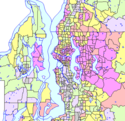At its peak, General Motors employed 350,000 people and operated 150 assembly plants. It defined “big business” for America and the world.
But GM was not always big. It grew through the acquisitions that it made in the early decades of the twentieth century. In those days, the automotive industry was populated by entrepreneurial small businesses led by people like Ransom Olds and Henry Ford. There were more than 200 automobile companies in the United States in 1920. By 1940, only 17 had survived. read more »






















